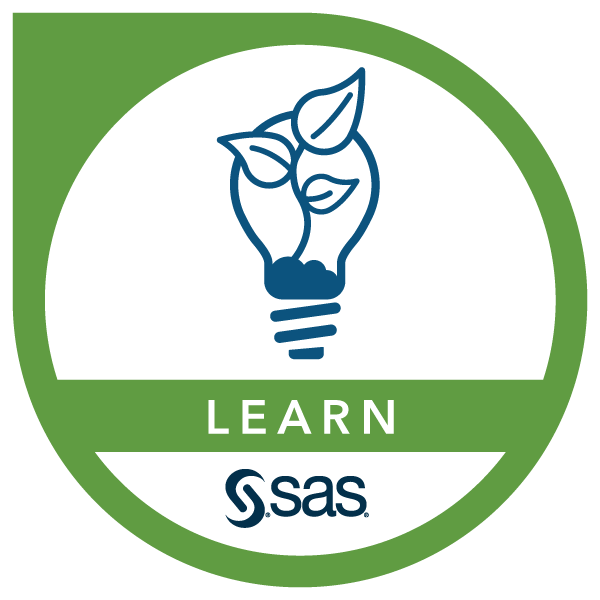SAS Biostatistics Learning Subscription
| Purchase this digital subscription to: | |
| Digital courses Unlimited access to digital courses and books. |
|
| Prepare for certification Unlimited access to certification preparation materials. |
|
| Shareable digital badges Earn a digital badge for each completed course. |
|
| Hands-on learning and practice Get Full access to SAS software to practice as you learn. |
|
About this Subscription
This learning subscription is for business analysts, statisticians, researchers, econometricians, and epidemiologists using SAS/STAT software in a variety of fields, including public health, pharmaceuticals, and medicine. SAS/STAT goes through rigorous software testing and quality assurance programs so that you can be confident that the code you produce is documented and verified to meet corporate and governmental compliance requirements. These biostatistics courses cover how to evaluate various statistical methods in order to apply the best one to answer your research questions.
Learn how to:
Before taking these courses, it is recommended that you take the SAS Programming 1: Essentials and Statistics 1: Introduction to ANOVA, Regression, and Logistic Regression courses, which are available in instructor-led or free online e-learning formats. The Statistics 2: ANOVA and Regression course or equivalent knowledge is also helpful.
Courses Included
Biostatistics
-
COURSE
Regression Methods Using SAS® Viya® SHOW LESS ︿This course covers nine regression methods. The models include linear, logistic, quantile, generalized linear, generalized additive, mixed, survival, nonlinear, and partial least squares. The applications, strengths, and weaknesses of each method are discussed, along with how the methods are implemented in SAS Viya. A comparison of the SAS Viya procedures and SAS/STAT procedures for each method is also shown. Examples in the course show applications in banking, financial services, direct marketing, insurance, telecommunications, medical, and academic fields.
The self-study e-learning includes:- Annotatable course notes in PDF format.
- Virtual lab time to practice.
ENROLL -
COURSE
Fitting Poisson Regression Models Using the GENMOD Procedure SHOW LESS ︿This course is for those who analyze the number of occurrences of an event or the rate of occurrence of an event as a function of some predictor variables. For example, the rate of insurance claims, colony counts for bacteria or viruses, the number of equipment failures, and the incidence of disease can be modeled using Poisson regression models.
This course includes practice data and exercises.
ENROLL -
COURSE
Survival Analysis Using the Proportional Hazards Model SHOW LESS ︿This course discusses survival analysis concepts with an emphasis on health care problems. The course focuses on the Cox proportional hazards model, not the parametric models, and is not designed for predictive modelers.
ENROLL -
COURSE
Statistical Analysis with the GLIMMIX Procedure SHOW LESS ︿This course focuses on the GLIMMIX procedure, a procedure for fitting generalized linear mixed models.
ENROLL -
COURSE
Programming with SAS/IML® Software SHOW LESS ︿This course teaches you how to use the IML procedure via the programming language. You benefit from this course if you plan to use SAS/IML for manipulating matrices, simulating data, writing custom statistical analyses, or working with R. The programs in this course require SAS/IML 12.3 or later to run.
The self-study e-learning includes:- Annotatable course notes in PDF format.
- Virtual lab time to practice.
ENROLL -
COURSE
SAS® Programming for R Users SHOW LESS ︿This course is for experienced R users who want to apply their existing skills and extend them to the SAS environment. Emphasis is placed on programming and not statistical theory or interpretation. Students in this course should have knowledge of plotting, manipulating data, iterative processing, creating functions, applying functions, linear models, generalized linear models, mixed models, stepwise model selection, matrix algebra, and statistical simulations.
ENROLL -
COURSE
Responsible Innovation and Trustworthy AI SHOW LESS ︿This course is designed for anyone who wants to gain a deeper understanding about the importance of trust and responsibility in AI, analytics, and innovation. The content is especially geared to those who are making business decisions based on machine learning and AI systems and those who are designing and training AI systems.
Whether you are a programmer, an executive, an advisory board member, a tester, a manager, or an individual contributor, this course helps you gain foundational knowledge and skills to consider the issues related to responsible innovation and trustworthy AI. Empowered with the knowledge from this course, you can strive to find ways to design, develop, and use machine learning and AI systems more responsibly.
We expect that each module can be completed in under an hour, and you can work at your own pace to complete the material. As we release new modules, you might lose progress through the material that you have completed, so please make a note of where you are leaving off before exiting the course.
ENROLL
SAS Products Covered
- SAS Viya
- SAS/STAT
- SAS/IML
- Base SAS
Digital Badges
Earn a digital badge for each course that you complete and for each credential that you earn. Show off your achievements on your resume and in your social channels to highlight your skills and connect with potential employers. |
 |
Certification Preparation
This learning subscription is not currently associated with a SAS credential.

“I think the self-paced training was the BEST I’ve ever taken. The videos were short and segmented correctly to keep my attention and the activities and quizzes were just enough to help my confidence.”